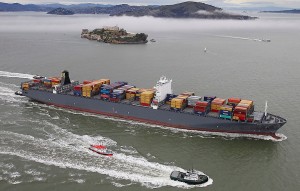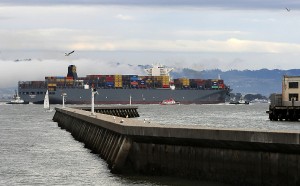Recently, we posted a piece looking at the impact of the new large container cargo ships on US ports and facilities.

And in that piece we citied a recent LA Times piece reminded us of the emergence of the mega-cargo ships arrival on the scene.
The largest cargo container ship to ever dock in the Americas made a fog-shrouded first voyage into the Port of Long Beach on Friday morning, sending a message to competitors that Southern California can handle the giant vessels most others can’t welcome for at least two more years.
Out by the breakwater, it looked as though a man-made island had sprung up overnight, but the dark shape was a vessel called the Fabiola, gliding very slowly toward port.
The Fabiola is one of a new generation of vessels that can carry 11,000 or more containers, favored by ocean cargo lines because packing more freight boxes onto each ship lowers costs.
“She’s way beyond our previous record for size,” said Dick McKenna, executive director of the Marine Exchange of Southern California, which logs the arrival and departure of all ships calling at the ports of Los Angeles and Long Beach, the nation’s largest seaport complex. “This is quite a significant jump for us.”
The Fabiola, owned by Geneva-based Mediterranean Shipping Co., can carry 12,500 containers. The ship is just 30 feet shorter than the Empire State Building is tall, as wide as a 10-lane freeway and big enough to carry the contents of eight 1-million-square-foot warehouses.
http://www.latimes.com/business/la-fi-big-ship-20120317,0,3972429,print.story
We have had a chance to discuss this development with Captain Cynthia L. Stowe, Commander of U.S. Coast Guard Sector San Francisco. We have interviewed Captain Stowe twice before, once during time in the Miami Sector and more recently after she had moved to the San Francisco sector.
SLD: Captain, how significant is the impact of the new mega container ships on the US maritime transportation system?
Captain Stowe: It’s a significant issue in terms of both logistics and waterways management because this larger class of container ship that is now arriving on the West Coast is the largest class of vessels to arrive in North America, although they’re not the biggest ships that are in service right now.
The FABIOLA class of container ship is here as a result of even larger ships entering European trade, freeing up these ships to enter the U.S. pacific trade. The reality is this class of ship presents a challenge in terms of the size of our existing port infrastructure and we don’t have a good offshore solution to container delivery. These arrivals are a unique challenge to the U.S. because of the costs associated with expansion of our port infrastructure, if it’s possible at all.

Recently, the Port of Oakland went from being the fifth busiest container port in the nation to the fourth busiest port. However, when you look at the inner and outer harbors in Oakland, the existing turning basins do not readily accommodate the size of these larger container ships.
The inner harbor turning basin is completely bounded by shipyard and various other facilities. We’ve got metal on all sides of the basin, so expansion is not possible. However, the Oakland Inner Harbor terminals are seeking larger ships due to the economical benefits that those ships bring.
The turning basin on the inner harbor was designed for a 980-foot ship to be able to turn. That was the original limit. About 10 years ago the harbors were deepened to 50 feet. At that time, the turning basin was reevaluated and based on enhance navigation equipment the size of ships was increased to 1,143 feet in length. The FABILOA measures 1,205 feet in length.
When the San Francisco Bar Pilots learned that the larger ships were bound for the West Coast, they conducted a simulation study at Cal Maritime Academy to determine the feasibility of bringing this larger class of vessels into the Port of Oakland. The study showed that if the pilots carried additional precision navigation equipment and the environmental conditions, ie winds and currents, were favorable, the larger ships could be turned in existing turning basins.
The equipment the pilots care is DGPS which is temporarily mounted on the bridge wing to allow the pilot to see the precise rate of turn of the bow, stern and the pivot point of ship. If enough tug horsepower is applied and we have ideal environmental conditions, it can be done.
SLD: Let me go back over what you have said so far to summarize. The first proposition is very simple — the ports of San Francisco and Oakland were built for a different age pre-container even with the anticipation of how cargo was handled kind of pre-container.
Secondly, obviously they’ve adjusted to the container age, but it’s been a challenge.
Now you bring in a ship that it’s a start of a whole different class of cargo ships where you’re going to have vastly increased in size. The trend line is much larger ships through widened canals.
The trend is real and it’s going to accelerate, and that means that the disconnect between the ships that are being built and will be servicing global economy and your ports, will grow. The disconnect is a major challenge. Is that a fair way to put it?
Captain Stowe: That’s a great summary of where we are right now. The requirements for port entry include winds less than 15 knots, current less than one knot and daylight turning only. Those conditions will challenge the speed with which we can move the ships through the Port of Oakland.
A number of additional conditions have to be met to bring these ships into our harbor. The pilots are requiring four tractor tugs, two 50-ton tugs, and two 80-ton tugs, which are the biggest tugs we have in the port. Additional, the pilots determined that they need two pilots in order to safety turn the larger ships. One pilot acts as an electronic pilot utilizing the DGPS tools and advises the lead pilot on the precision navigation during the turn of the ship.
Additionally, impacts are being felt on the other port partners when the larger container ship arrive including a requirement to stop any bunkering operations, and watch for surge interaction as the ship pass.
Security’s an important piece of this as well because larger ships equate to the cargo being delivered at a more rapid rate. We just saw a new Supply Chain Security Strategy come out of the White House, which will help to focus our attention on the security aspects of the trade.
SLD: How do you manage the security challenge of the container ships?
Captain Stowe: We typically see 9,000 containers on each ship. Now, that number can be as high as 12,600 containers per ship. The Coast Guard has a very good risk-based model for determining which ships present a higher security risk. We look at the ship – where it’s been, its owners – and determine which ships present a higher risk.
We board high risk ships at sea. Coast Guard Security Boarding Team members board these ship 12 miles offshore where they conduct crew accountability and conduct a sweep of the ship. However, this doesn’t account for the contents of the containers. Customs and Boarder Protection Agency established an international inspection system through their Container Security Initiative, which has placed U.S. inspectors around the globe to ensure the security of the contents of containers.
SLD: Managing the safety side of this must be very challenging as well with the limited resources at your disposal.
Captain Stowe: One of the roles of the Coast Guard is to ensure that companies involved in shipping have established effective safety management systems for the operation of their ships while in U.S. ports. Shipping lines worldwide must make reasoned decisions about bringing their ships into our ports including an assessment of risk associated with these larger ships entering our yet to be expanded U.S. port infrastructure. There will be pressure on U.S. ports to receive these larger ships and it’s incumbent on all of us to make sure we don’t wait for an accident to happen before we decide the ships are too large.
I’m currently not resourced to establish a moving safety zone around every ship coming into port. Additionally, port partners are concerned about the impact on their operations during the transit of the larger ships.
SLD: So what are some of the resources that would be helpful to deal with this evolving challenge?
Captain Stowe: Above all, there is a clear need for port infrastructure investments. The demand for dredging, and port expansion has far outweighed the Army Corps of Engineers ability to deliver. As a result, the port infrastructure hasn’t kept up with demand and the larger ships are here.
Around the world, competent authorities tell commercial ships where they may go within their ports. However, in the U.S. we place the burden on the shipping company to assess and remain responsible for their ships intended routes. In the future, it’s clear that the larger ships will require the oversight of all involved parties to ensure the safety and environmental protection of our ports.
SLD: You need obviously some manpower to do these tasks as well, and what kind of assets you’d like to have as you go forward?
Captain Stowe: Post 9/11, the Coast Guard took on a greatly expanded security role in our ports. We have a certain amount of small boats and crews to execute our traditional missions and our newer security responsibilities. When we add additional responsibilities we become challenged to do everything.
With each of the recent arrivals of the larger container ships, the Coast Guard put a moving safety zone around the ship, we put a safety team on the ship, and assigned small boats to enforce the zone in order to keep recreational vessels at a safe distance. That equates to an increased workload.
There is ongoing research into the feasibility of moving the delivery of containers offshore as the ships get larger and our ports do not. The offshore element is also viewed as possibly providing enhancements in container security. If that were to occur, the Coast Guard would need assets to be able to oversee our port safety and security responsibilities.
SLD: This would translate as well into a requirement for some new boats as well to manage the maritime transportation system?
Captain Stowe: I believe it would require a different class of vessels for us. San Francisco has four 87-foot Coastal Patrol Boats that are very light and are capable of operating in the offshore environment, but they also have a job in the ports as well. A ship with enhanced endurance would likely be necessary to continually operate 50 to 100 miles offshore. The Fast Response Cutters (FRCs) are a better look in that direction, however, none of those ships are slated to come to our AOR.
Credit for the Photos:
The MSC Fabiola, the largest container ship to pay call at any seaport in North America, arrived at the Port of Oakland on Thursday, March 21, 2012. The ship is 1,201 feet long, more than the length of four football fields, has a breadth of 158 feet, weighs 146,093 metric tons and has a top speed of 25.3 knots. The Fabiola was piloted by several San Francisco Bar Pilots, Capt. Dave McCloy, of Berkeley, and Capt. Ed Melvin. Also aboard to observe was U.S. Coast Guard Capt. Cynthia Stowe. The ship came from the Port of Long Beach and will depart again on Thursday for an 18-day voyage back to China.

